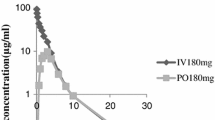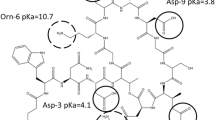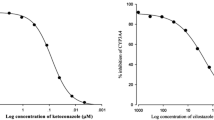Summary
Imipenem is inactivated by the renal dehydropeptidase I, which can be inhibited by cilastatin. Therefore, both compounds are administered in combination. According to the manufacturers, they are not nephrotoxic in rats. 70 female Wistar rats (n=10 /test series) were treated over five days at dosage intervals of 12 hours with intraperitoneal injections (injection volume: 10 ml/200 g body weight) of isotonic 0.9% NaCl, cilastatin (1000 mg/kg/day), imipenem (500 and 1000 mg/kg/day), cilastatin + imipenem (500 or 1000 mg/kg/day each) and cefsulodin (1000 mg/kg/day). The nocturnal excretion of renal tubular cells was determined. Furthermore, three rats in each test were treated intraperitoneally with 150 mg/kg imipenem or with the combination of imipenem and cilastatin (150 mg/kg each). Imipenem concentrations were measured over four hours in the blood of the tail vein. Commencing on the second day of study, cilastatin, imipenem and the combination of both substances induced significant surplus excretion of tubular cells compared to the control group. The tubulotoxic effects of imipenem and imipenem + cilastatin in combination were dose-dependent. The toxic effects of imipenem, imipenem + cilastatin and cefsulodin did not significantly differ. Cilastatin prolonged the half-life of imipenem in the blood from 0.4 to 0.9 h and increased the AUC of imipenem from 156 to 325 mg/l/h. Thus, the tubulotoxic potency of imipenem and imipenem + cilastatin in combination can be considered similar to that of pyridinium-substituted cephalosporins. Cilastatin increases the bioavailability of imipenem, probably as a result of competitive displacement at the renal tubular cell. However, it is not possible to measure to what extent the renal tubular cell is protected by cilastatin from the toxic effect of imipenem as cilastatin itself is also tubulotoxic.
Zusammenfassung
Imipenem, (das erste verfügbare Thienamycin-Derivat, ein Betalactam-Antibiotikum mit breitem Spektrum,) wird durch die renale Dehydropeptidase I inaktiviert, die durch Cilastatin gehemmt werden kann. Daher werden beide Substanzen kombiniert verabfolgt. Sie sollen bei der Ratte, nach Angaben des Herstellers, nicht nephrotoxisch sein. 70 weibliche Wistar-Ratten (n=10/Serie) wurden über fünf Tage bei einem 12-Stunden-Dosierungsintervall i.p. behandelt (injiziertes Volumen: 10 ml/200 g Körpergewicht) mit 0,9% NaCl, Cilastatin (1000 mg/kg/Tag), Imipenem (500, 1000 mg/kg/Tag), Imipenem + Cilastatin (je 500 oder 1000 mg/kg/Tag) und Cefsulodin (1000 mg/kg/Tag) und die nächtliche Ausscheidung an Tubuluszellen bestimmt. Je drei Ratten wurden i.p. mit 150 mg/kg Imipenem bzw. je 150 mg/kg Imipenem + Cilastatin behandelt und die Imipenem-Konzentrationen im Schwanzvenenblut über vier Stunden gemessen. Cilastatin, Imipenem und Cilastatin + Imipenem führen vom zweiten Versuchstag an zu einer im Vergleich zur Kontrolle signifikanten Mehrausscheidung an Tubuluszellen. Die tubulotoxischen Wirkungen von Imipenem und Cilastatin + Imipenem sind dosisabhängig. Die toxischen Effekte von Imipenem, Cilastatin + Imipenem und Cefsulodin unterscheiden sich nicht signifikant voneinander. Cilastatin verlängert die Halbwertszeit von Imipenem von 0,4 auf 0,9 Stunden im Blut und vergrößert die AUC von Imipenem von 156 auf 325 mg/l/Stunde. Demnach ist die tubulotoxische Potenz von Imipenem und Cilastatin + Imipenem ähnlich einzuschätzen wie die von Pyridinium-substituierten Cephalosporinen. Cilastatin erhöht die Bioverfügbarkeit von Imipenem, wahrscheinlich aufgrund einer kompetitiven Verdrängung am Tubulus. Die infolgedessen zu erwartende Protektion des Tubulus durch Cilastatin vor der toxischen Wirkung von Imipenem wird jedoch nicht meßbar, da Cilastatin ebenfalls tubulotoxisch wirkt.
Similar content being viewed by others
Literature
Alestig, K., Trollfors, B., Anderson, R., Olaison, L., Suurküla, M., Norrby, S. Ceftazidime and renal function. J. Antimicrob. Chemother. 13 (1984) 177–181.
N. N.: Products information, Cefsulodin sodium. Japan Medical Gazette 5 (1981).
Calandra, G., Hesney, M., Grad, C. A multiclinic randomized study of the comparative efficacy, safety and tolerance of imipenem/cilastatin and moxalactam. Eur. J. Clin. Microbiol. 3 (1984) 478–487.
Ribner, B., Raeder, R., Hollstein, M., Freimer, E. A randomized study comparing clinical efficacy and safety of thienamycin formamidine/renal dipeptidase inhibitor and cefazolin. J. Antimicrob. Chemother. 12 (1983) 387–391.
Sack, K. Experimentelle Untersuchungen zur Nierenverträglichkeit der Cephalosporin-Antibiotika. Schweiz. Rundschau Med. (Praxis) 69 (1980) 875–882.
Sack, K., Schulz, E., Brodersen, H. Experimentelle Nierenschädigung durch drei Pyridinium-substituierte Cephalosporine. J. Clin. Chem. Clin. Biochem. 21 (1983) 245.
Tune, B., Fravert, D. Mechanisms of cephalosporin nephrotoxicity: a comparison of cephaloridine and cephaloglycin. Kidney Int. 18 (1980) 591–600.
Cojocel, C.: Personal communication.
Merck, Sharp & Dohme: Imipenem, the first thienamycin antibiotic. An interim technical background prepared for the 13th International Congress of Chemotherapy, Vienna 1983.
Sack, K. Die Differenzierung der Nierenverträglichkeit verschiedener Cephalosporine im Tierexperiment. Infection 4 Suppl. 3 (1976) S237-S245.
Sack, K., Freiesleben, H., Schulz, E., Marre, R., Henkel, W. Experimental investigations on renal tolerance and therapeutic efficacy in pyelonephritis of cefuroxime. Proc. Royal Soc. Med. 70 (1977) 134–138.
Sachs, L. Angewandte Statistik. Springer, Berlin 1974.
Barza, M. Imipenem/Cilastatin. Eur. J. Clin. Microbiol. 3 (1984) 453–454.
Author information
Authors and Affiliations
Rights and permissions
About this article
Cite this article
Sack, K., Herhahn, J., Schulz, E. et al. Renal tolerance of impienem/cilastatin and other beta-lactam antibiotics in rats. Infection 13 (Suppl 1), S156–S160 (1985). https://doi.org/10.1007/BF01644239
Issue Date:
DOI: https://doi.org/10.1007/BF01644239




